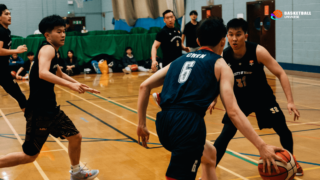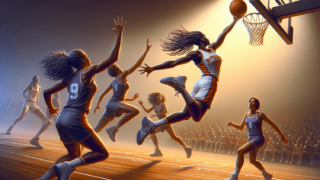
Injured Player Rule in Basketball
Written by: Basketball Universe
Last updated:

🏀 Imagine what would happen if an injured player had a chance to bounce back, their team saved from the angst of losing their star player! That’s precisely what the Injured Player Rule in basketball does. 🚑 Curious, aren’t you? Gear up, fellow basketball enthusiasts, as we dive into the intriguing hoops and alley-oops of the Injured Player Rule🤕. Our comprehensive guide will make you a formidable expert on this topic, whisking you through every vital detail with a fun and professional touch. As the saying goes, “Knowledge is power!” Let’s elevate your understanding of the game with a dose of that power.📚🏀
Injured Player Rule in Basketball
The Injured Player Rule in basketball refers to a provision that allows NBA teams to temporarily replace a player who has suffered a long-term injury. To qualify, the injured player must be expected to be out for a minimum of six months. Once the team receives approval from the league, they are granted a Disabled Player Exception, which permits them to sign, trade, or claim a replacement player without waiting for the injured player to recover fully. This rule aims to maintain competitive balance within the league and ensure that teams have the opportunity to overcome the loss of a significant player.
Understanding the Injured Player Rule in Basketball
Often overshadowed by the flashy on-court action, the inner workings of basketball rules are just as exciting and integral to the sport. One such rule, the Injured Player Rule, is an essential part of how NBA teams handle injuries to key players. To provide a clear and extensive understanding of this rule, we’ll dive into its various components and situations in which it comes into play. So buckle up, and let’s explore the Injured Player Rule together!
An Overview of the Injured Player Rule
Like any sport, basketball is a physical game where injuries are inevitable. Beyond the implications for the player’s wellbeing, injuries can lead to roster gaps and potential disadvantages for teams. To address these concerns, the NBA has established the Injured Player Rule, which allows teams to temporarily replace a player who has suffered a long-term injury.
Disabled Player Exception
The Disabled Player Exception (DPE) provides teams the financial means to acquire a replacement player due to injuries. It functions as a vital mechanism within the larger framework of the Injured Player Rule. The DPE’s amount is determined by 50% of the injured player’s salary or the amount of the Non-Taxpayer Mid-Level exception, whichever of the two is less.
Eligibility Criteria
Not every injury qualifies for the Injured Player Rule. An NBA team can invoke the rule and apply for the DPE if the following criteria are met:
- The injured player is expected to be sidelined for a minimum of six consecutive months.
- The injury occurred on or before November 30 and has been verified by an NBA-designated physician.
- An NBA-designated Fitness-to-Play panel confirms the injury diagnosis.
If these conditions are satisfied, the team can start the process of acquiring a replacement under the Injured Player Rule.
Putting the Injured Player Rule into Action
Once the NBA grants a team the Disabled Player Exception, it can proceed to acquire a new player by signing a free agent, making a trade, or claiming one off waivers, using the provided exception amount. Let’s explore each method in detail.
Signing a Free Agent
Teams can utilize the DPE to sign a free agent to a one-year contract, ensuring a temporary solution to an unexpected roster gap. The contract value cannot exceed the DPE or the league minimum, plus $100,000. Given the temporary nature of the contract, signing a free agent is a viable option for teams seeking a short-term solution under the Injured Player Rule.
Trading for a Replacement
When it comes to trading, the DPE enables a team to trade for a player in the last year of their contract, with an added restriction on the incoming player’s salary. The salary of the incoming player cannot exceed the DPE plus $100,000. Utilizing the DPE in a trade often signifies that the team is interested in a more long-term solution, as the newly acquired player’s contract would extend beyond the injured player’s recovery period.
Claiming a Player off Waivers
Similar to making a trade, a team can claim a player off waivers if that player is in the final year of their contract. The incoming player’s salary is bound to the same restrictions as trading and must not exceed the DPE plus $100,000. This scenario is less common amongst NBA teams but allows options for teams looking for a replacement under the Injured Player Rule.
Exploring Notable Instances of the Injured Player Rule
The rich history of the NBA is riddled with examples of teams invoking the Injured Player Rule to their advantage. Familiarizing yourself with these notable cases will help you better understand the rule’s real-world applications.
Boston Celtics – Gordon Hayward Injury
In the 2017-2018 NBA season, Gordon Hayward suffered a devastating ankle injury in his debut game as a Boston Celtic. The NBA granted the Celtics a Disabled Player Exception worth $8.4 million, allowing them to temporarily fill Hayward’s roster spot.
Miami Heat – Alonzo Mourning Kidney Disease
During the 2000-2001 NBA season, Alonzo Mourning was diagnosed with a life-threatening kidney disease that forced him to miss the entire season. Invoking the Injured Player Rule, the Miami Heat signed Cedric Ceballos as a temporary replacement. Mourning made his triumphant return later in his career, overcoming adversity and showcasing the resilience of both the player and the importance of the Injured Player Rule.
Crucial Points to Remember
The Injured Player Rule is a fascinating component of the NBA’s collective bargaining agreement and a crucial tool for teams. As you continue to expand your knowledge of basketball rules, keep these key points in mind:
- The Injured Player Rule is designed to maintain competitive balance within the league and help teams overcome an injured player’s loss.
- Teams can apply for the Disabled Player Exception if specific eligibility criteria are met, and a player is expected to be out for a minimum of six consecutive months.
- Tactics to acquire a replacement player include signing a free agent, trading for a player, or claiming a player off waivers.
By mastering the intricacies of the Injured Player Rule, you’ll command an even greater understanding and appreciation for the complexities of our beloved game. Basketball rules encapsulate a world of strategy and resilience that elevates the sport beyond just the display of athleticism and skill.
Looking Forward: Injured Player’s Return
Now that you possess a comprehensive understanding of the Injured Player Rule, it’s essential to discuss the element that brings the process full circle: the injured player’s triumphant return to the court. Basketball aficionados know all too well the roller coaster of emotions during injuries, with the ultimate redemption being a successful and healthy comeback.
Injured Player’s Recovery and Return
While the Injured Player Rule aims to preserve a team’s competitive balance, it also has profound implications for the injured player’s journey. This section will discuss the stages of recovery, the process of returning to the lineup, and the impact on the team’s roster and salary.
Rehabilitation and Recovery
Injured players undergo an extensive rehabilitation process to promote healing and prepare for their eventual return. This phase involves medical treatment, physical therapy, and strength and conditioning programs tailored to the player’s condition and needs. Throughout this challenging period, the player and team’s medical staff closely monitor progress to ensure a safe and successful recovery.
Return Timetables and Fitness-to-Play Panels
The recovery process can be uncertain, with return timetables subject to change based on various factors, such as the nature of the injury, response to treatment, and potential setbacks. In some cases, the NBA-designated Fitness-to-Play panel plays an essential role in evaluating the player’s readiness to return to action. This panel assesses a player’s health and collaborates with team medical staff to facilitate an optimal recovery.
Impact on Roster Management and Salary Cap
Once the injured player is ready to return to action, their reintegration to the squad can have implications on the team’s roster management and salary cap situation, especially if the replacement player remains on the roster.
Roster Changes
Upon the injured player’s return, teams must create a roster spot by either releasing the replacement player or making changes elsewhere on the roster. This stage requires careful planning and strategic decision-making from coaches, players, and team management.
Salary Cap Implications
The injured player’s return also impacts the team’s salary cap. If the team signed a free agent as a replacement under the Disabled Player Exception, that player’s salary disqualifies them from using the exception. However, the financial implications depend on the team’s existing cap situation, remaining roster spots, and luxury tax considerations.
A Deeper Connection to the Game
By delving into the full spectrum of the Injured Player Rule, from the initial injury to a player’s return, we gain a deeper understanding of and connection to the game. This insight enables us to appreciate the strategic aspects of team management and the immense effort that goes into preserving a team’s competitive balance. The Injured Player Rule plays a vital role in shaping the landscape of the NBA, and a deeper understanding of it equips you with a greater appreciation for the resilience, determination, and passion that drive our beloved game.
Frequently Asked Questions
To further enrich your understanding of the Injured Player Rule, we’ve compiled a helpful FAQ section that addresses common questions related to this fascinating aspect of basketball. Below, you will find concise answers to some of the most frequently asked questions on the topic, providing quick insights to satisfy your curiosity.
1. Is there a deadline for teams to apply for the Disabled Player Exception (DPE)?
Yes, teams must apply for the DPE before January 15th of the current NBA season.
2. Can a team use the DPE if a player is injured for less than six months?
No, a team can only apply for the DPE if the injured player is expected to be out for a minimum of six consecutive months.
3. Can the DPE be used multiple times within a season?
No, the Disabled Player Exception can only be used once per season for a single injury incident.
4. Can the DPE be combined with other salary cap exceptions?
No, the DPE cannot be combined with other salary cap exceptions, such as the Mid-Level Exception or Bi-Annual Exception.
5. What happens if the injured player recovers faster than expected?
If the injured player returns to action before the expected recovery time of six months minimum, they may resume playing for the team. However, the Disabled Player Exception remains in effect until its expiration date, regardless of the injured player’s recovery timeline.
6. How is the amount of the Disabled Player Exception determined?
The DPE is determined by 50% of the injured player’s salary or the amount of the Non-Taxpayer Mid-Level exception, whichever of the two is less.
7. What happens to the replacement player when the injured player returns?
When the injured player returns, the team must create a roster spot by either releasing the replacement player or making changes elsewhere on the roster.
8. Can a team retain the replacement player for the following season?
Yes, a team can retain the replacement player for the following season, depending on their contract terms and the team’s roster needs.
9. How does the Fitness-to-Play panel factor into the Injured Player Rule?
A Fitness-to-Play panel validates the injury diagnosis by confirming the eligibility criteria for the Injured Player Rule. The panel can also assess a player’s readiness to return to action and collaborate with the team’s medical staff on the recovery process.
10. How does the Injured Player Rule impact a team’s salary cap situation?
When the Disabled Player Exception is used to acquire a replacement player, it impacts a team’s salary cap by adding the replacement player’s salary to the cap sheet. Upon the injured player’s return, the team may need to release the replacement player or make other roster changes, which could also impact the salary cap.
Featured Posts
- No pillar pages found.





